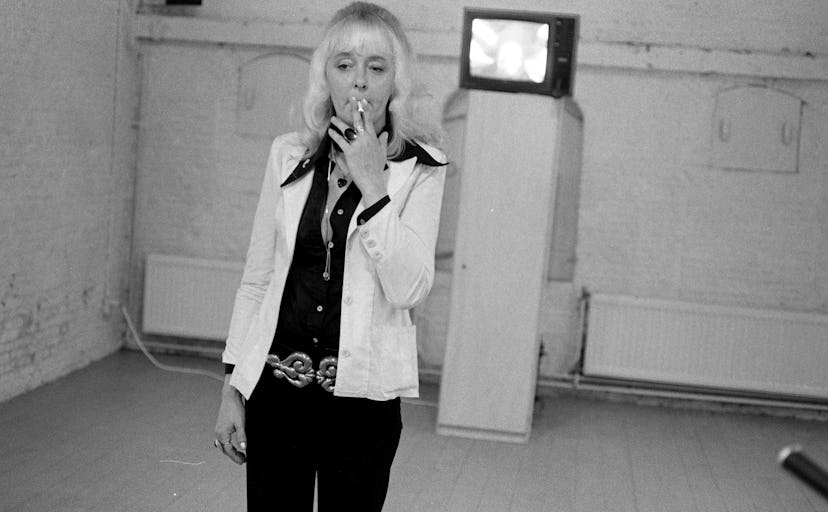How to Walk the Streets Like Jenny Holzer and Marina Abramovic
A new exhibition at the Barnes Foundation showcases how flânerie has come a long way from French Impressionism and high society—all the way to parading down Fifth Avenue wearing raw meat, in fact.

In 1998, on Fidel Castro’s birthday, the Cuban artist Tania Bruguera went for one of her usual strolls through the streets of Havana. Not that you could have recognized her. For the occasion, Bruguera suited up in an earthen hazmat suit made of dirt, cloth, and menacingly outward-pointing nails—essentially a walking nkisi nkonde, or relic of a Congolese religious fetish. A comment on the Cuban administration’s promises to its people at the time, her birthday suit now stands sentinel at the center of a room off the many Renoirs, Matisses, and Picassos at the Barnes Foundation in Philadelphia, greeting visitors to “Person of the Crowd: The Contemporary Art of Flânerie,” an exhibition exploring a definition of flâneur much different from the one first known to French artists.
Marina Abramovic, Zhang Huan, Tania Bruguera, and More of Today’s Modern-Day Flâneurs
Zhang Huan, “My New York: performance,” 2002 Biennial Exhibition, Whitney Museum of American Art, New York, 2002.
Marina Abramović, “Role Exchange,” Performance, 4 hours, De Appel Gallery, Red Light District, Amsterdam, 1975.
Marina Abramović, “Role Exchange,” Performance, 4 hours, De Appel Gallery, Red Light District, Amsterdam, 1975.
Pope.L, “The Great White Way,” 22 miles, 9 years, 1 street (Whitney version), 2001.
Tania Bruguera, “Displacement, 1998 – 1999.” Medium: Embodying a Nkisi Nkonde icon, Behavior Art.
Brett Day Windham, “Rosary,” 2008- 2013.
Eleanor Antin, “Eleanor Antin as The King,” 1972.
Eleanor Antin, “The Wonder of It All,” 1974-75. From The King of Solana Beach.
Eleanor Antin, “The Wonder of It All,” 1974-75. From The King of Solana Beach.
Arman, “Petits Déchets Bourgeois,” 1959, Accumulation of household garbage in wood box with glass cover.
Brett Day Windham, “Rosary,” 2008- 2013.
Sanford Biggers, “Duchamp in the Congo,” 1997. Wood, nails, mixed media.
Sanford Biggers, “Suburban Invasion,” 1998.
Sanford Biggers, “Suburban Invasion,” 1998.
Sanford Biggers, “Suburban Invasion,” 1998.
Keith Haring, “Untitled (Still Alive in ‘85),” 1985. Chalk on paper.
Ingrid Calame, “g’-kgg kooo-kggkoo- kggkoo,” 2003.
Fittingly, Bruguera’s figure is not alone. The show is peopled with the presences of more than 50 other artists, from photographs documenting the time that Marina Abramovic switched places with a prostitute for four hours in 1975, setting up shop in her window in Amsterdam’s red light district (Abramovic sent the woman to her gallery opening in her stead), to video of the day in 2002 when the Chinese artist Zhang Huan stitched together pieces of raw meat, strapped them to his body, and strolled through the streets of the then-uptown Whitney Museum, releasing white doves as a gesture of compassion inspired by Buddhism (despite all the animal cruelty). Along with works and performances by artists like Ed Ruscha, David Wojnarowicz, Francis Alÿs, Jenny Holzer, and Vito Acconci, there’s also footage from the eight years the artist Pope.L spent crawling the length of Manhattan in a Superman costume, a skateboard strapped uselessly to his back, and relics of Brett Day Windham’s five years of picking up one object on the ground every day on the walk to her studio, now strung up in a row like decorations for a party.
Such are the gritty ways flânerie has manifested itself in the art world in recent years. It’s a far cry from when Edgar Allen Poe first introduced the concept to the public with his short story “The Man of the Crowd,” and flâneurs mostly stuck to observing high society (and being a part of it—after all, they have nothing better to do than stroll). Its reinvention, though, which started back up in the mid-19th century, thanks to artists like Robert Rauschenberg turning to the pavement for his collage materials, is much more indicative of today’s streets. That is, when they’re not filled with marches and protests.
See Kendall Jenner, Performance Artist, Channels Icons Like Marina Abramovic and Yoko Ono: